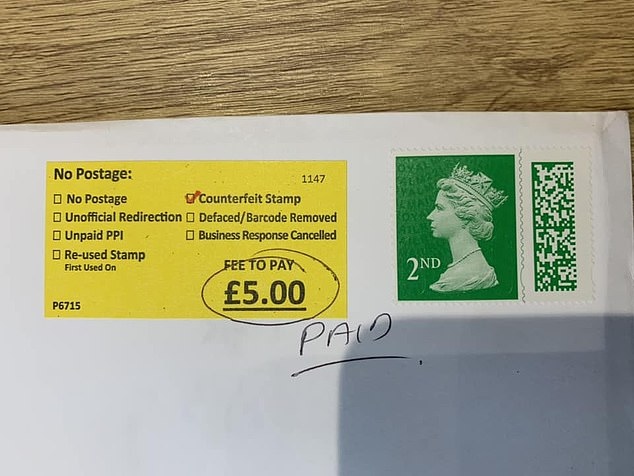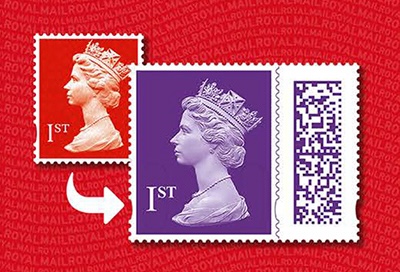Royal Mail has charged £5 to receive cards with counterfeit barcoded stamps it supplied
Royal Mail and the Post Office have sparked yet another row this time over charges for so-called counterfeit stamps and the increased £5 penalty for recipients of mis-stamped mail.
In the middle of fears for the future of the postal service in the UK as there are fears over cuts in the universal service obligation, the Daily Mail has highlighted a surge in people being told the stamps with barcodes they’ve used to send letters and cards are counterfeit.

There’s also been a problem as people try to stock up with stamps, which now only display 1st or 2nd class so continue to be valid when price rises come into effect, as they will do on Tuesday, 2 April, as supplies appear to be short.
When Maggie Wynn rang for a delivery of stamps to her Just Cards store in Honiton, the order was confirmed and payment taken, only for a return call to be received claiming she had “received her allowed allocation” despite not having bought any stamps this month nor ever being told previously there was a limit – her payment was refunded and she was told to order again on Tuesday, after the price increase kicks in.
The issue with alleged fakes stems from stamps as they’ve been known since the 1840 introduction of the Penny Black, the world’s first adhesive stamp to pre-pay for postage, being changed to those with barcodes which RM introduced two years ago claiming it enables mail to be tracked more easily and offers enhanced security features.
Under the Stamp Swap Out Scheme, customers could exchange old stamps which couldn’t be used – apart from special Christmas and picture stamps – after July 2023, for barcoded ones by printing an online form, requesting a Stamp Swap Out form online to be posted to you, visiting a local delivery office, calling customer services, or collecting the form and freepost envelope from local Post Offices.
But the Daily Mail has evidence from readers including Tony Marcella who received one of Royal Mail’s fee-to-pay notices, but then only way to find out who the letter is from is to pay up and collect it.
He found it was a card from a pal and had what looked to be the correct postage but a yellow sticker on the envelope had the box ticked for “counterfeit stamp” having been picked up by the RM scanning system – as with bank notes, stamps are a secure print item so it is a crime to knowingly reuse or sell used or fake stamps.

Tony, from Rugby, told the paper his friend explained it was one of 103 she had received direct from the Royal Mail after exchanging £95.69 worth of non-barcoded stamps through the Stamp Swap Out scheme.
She’d sent over 20 cards with that batch, earning Royal Mail at least £100 in penalties if every one was charged as the fee for no postage or counterfeit stamps doubled from £2.50 to £5 in October, and to £7 for small parcels, with the underpayment charge staying at £1.50, while using non-barcoded stamps now earns the recipient a £2.50 penalty instead of the previous £1.10.
Tony couldn’t see any differences between the stamp on his card and others he compared it to, and the newspaper’s expert at Corbitts auctioneers, in Newcastle Upon Tyne, also believes it’s genuine.
Pat James, from Nailsea, also had a £5 charge for a card from a former neighbour for the same reason, but can’t see any discolouration, strange marks or errors on the alleged fake stamp and told the Daily Mail: “The barcodes were supposed to help improve things. The price of stamps is going up but the service is going down. I now send people virtual cards.”
Royal Mail will only refund the surcharge if it receives the envelope with the supposedly questionable stamp and proof of the exact location where the stamp was bought – difficult for the recipient to provide – and decides it was a genuine stamp after all.
And commentors on the newspaper article pointed out that they had followed this process only for Royal Mail to insist it was a counterfeit stamp even if proof of purchase from Royal Mail or the Post Office has been provided, and refuse to return it so no further checks can be made.
It’s unclear at what point these allegedly counterfeit stamps have entered circulation, and their source — or whether they are genuine and Royal Mail’s scanning technology is at fault.
One postal worker in Kent, who wishes to remain anonymous, said either the machines used to scan the stamps at sorting offices are faulty or there’s a problem at the printers that manufacture the stamps, rather than a criminal network within Royal Mail making money out of fake stamps.
The Post Office says that it receives its stamps directly from the Royal Mail’s secure printers, which it delivers to its branches in secure vans or sends them via secure post from its warehouse in tamper-proof envelopes.
A Royal Mail spokesman told the paper it “uses a controlled process which is secure and robust for the distribution of our stamps and stamp products, including stamps supplied to customers through our Swap Out scheme”.
























